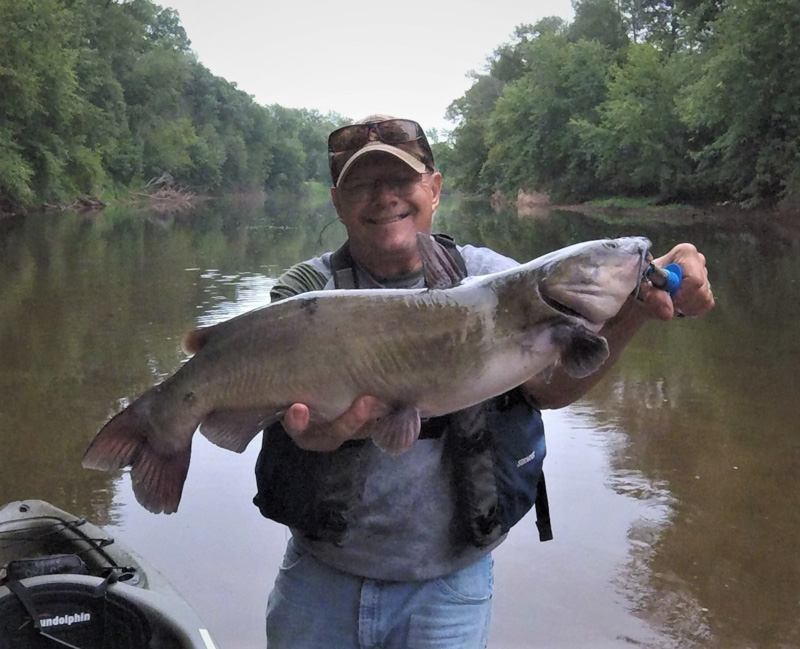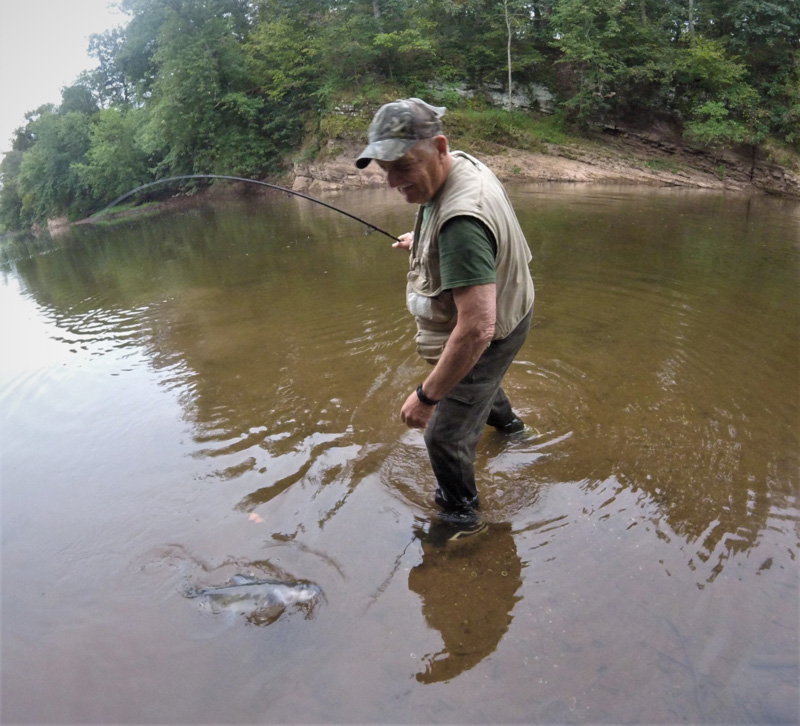My good friend Alvie Sickle had told me there were certain sections within the Monocacy River watershed where five, six, even 10-pound channel catfish could be had — with the chance of even bigger fish. I had heard the stories, and even experienced this small-water catfish gig to a lesser degree. But it seemed to me that fish of that size were more likely to dwell in larger systems like the mainstream Potomac, Susquehanna, or larger Upper Bay river environs. I was wrong.

For the past several years we had made it a plan to hit various sections of the Monocacy and various tributaries along with some local, down-sized public waters where channel cats had been stocked years prior only to be forgotten about. Most of our trips were during early to late summer but a few had been slated for early fall. This was part of our seasonal efforts to zero in on catfish and carp when other “headline” species were less cooperative in the summer heat.
Most people wouldn’t think that an overlooked community pond or a small lazy river could offer the chance to catch a big, brawny channel cat that might exceed the 30-inch mark. But it happens, and it happens more often than one would think. Smaller flows like the Monocacy, Conowago, Patuxent, Bush, or both forks of the Shenandoah will see smallmouth anglers hook and land a big channel cat by “accident” every so often, and consider it a rare catch. Not really. Big channel catfish are hardy and tough. They are holding their own in some areas where the invasive blue cats threaten to overrun them, and they remain one of the best eating catfish out there. Here’s a game plan for small water success.
Catfish in Community Lakes and Ponds
It will take a bit of searching, but there are a host of mini-waters that have channel catfish in them and most are quite under the radar. Fisheries management organizations have frequently stocked keeper-sized channel cats in various small venues to assist in children’s fishing rodeos, or just to spice up the angling variety in some of these waters. Frequently they are forgotten about and some of these fish grow to amazing proportions. The largest channel catfish I have ever heard of locally came from a tiny two-acre public pond within the city limits of a Maryland city of 30,000 people. That fish weighed just shy of 23 pounds and at the time challenged the state record. Over the years, I have personally caught and released a number of 30-inch plus cats from a variety of community lakes, club ponds and private farm ponds as well. My two largest channel cats came from low-key, public ponds that were more famous for trout stocking than cats.
Channel catfish seldom reproduce in small lakes due to the lack of cavernous spawning habitat. Items like hollowed out logs, undercut banks or deeper rock crevices allow for aggressive males to guard the eggs and fry once the females drop their eggs. This doesn’t exist in most small, dishpan-shaped ponds from two to 20 acres. However, some random reproduction could possibly occur. Most smaller lakes are supported through stocking efforts with eater-sized fish that can evade capture and grow to the trophy 30-inch class. Most cats of that length will weigh 10 to 12 pounds with some heavier.
Many baits and food items are on the small lake catfish menu, with the classic chicken livers being at the top of the list. You can tie livers on a 2/0 baitholder-style hook with string or rubber bands to keep it on. In the past we have made “liver sacs” with cheese cloth squares, tied them up twisty ties, and clipped them off tight to the sac. Simply thread a hook though one end of the sac and toss it out, leaving the bail open for a hungry catfish.
Additionally, fresh, live, and cut sunfish or bluegills can be an excellent bait that is a common forage for small-water cats. Don’t be afraid to suspend cut or live baits below a bobber for prowling cats, especially during low-light periods or cloudy days. We like to use standard bass gear with 10- to 15-pound test braids to fish for pond fish and medium spinning gear will do fine in most situations.
Catfish in Small Rivers and Creeks
A few years ago, I caught an eight-pound channel cat on a tiny crank bait from a meadow stream in Frederick County, MD. The 27-inch fish crushed the midget lure and a long, hard, tense battle ensued. As I was cautiously playing the fish on ultralight gear, I was astonished to see yet another, larger 30-inch class catfish following it — wow! I later found out that this particular hole had produced cats up to 12 pounds and smallmouths up to 19 inches, even in recent years. Huge fish for such demure waters. It just strengthened my belief that an exceptional fish can live just about anywhere, especially if the area is remote or lightly fished.

Channel cats are found in most Chesapeake tidal tributaries and in years when dry to drought conditions push salinity levels down and downstream, a percentage of those fish remain in the creeks and hole up during hot conditions. The same applies for free-flowing rivers and the Upper Potomac or Susquehanna tributaries. A “deeper” hole is relative, and a four-foot pocket can house a number of large adult fish. But deeper the better. At these times, catch and release is strongly recommended as the breeder cats can be vulnerable and over harvest can occur due to angler glut.
In the rivers, our best cats traditionally take a variety of cut sunfish species or live baits such as bluegills and green sunfish. With longer, deeper, slow-moving pools, weight is not required for fishing these in a natural manner. If there is a large eddy, then you can suspend baits on a float as well. Try to keep baits a foot or two off the bottom, as small river kitties can be caught at any depth from the bottom to even on a surface plug.
We like to up our gear a bit by using 20-pound clear monofilament and 2/0 to 4/0 hooks to secure the baits. Chicken livers can do well but are often messed with by the smaller sunfish, minnows, or crayfish that are likely present. Also, we frequently utilize our kayaks to paddle to more secluded and remote areas of smaller river systems to catch fish that are not pressured by the masses at those “community holes.”
Yes, small-water channel cats, are out there and they are willing to bite throughout the summer. Give it a shot this year for an exciting, big-fish adventure in small waters.
-By Jim Gronaw
Sign up here to get the weekly FishTalk Chesapeake Bay and Mid-Atlantic fishing reports in your email inbox, every Friday by noon.